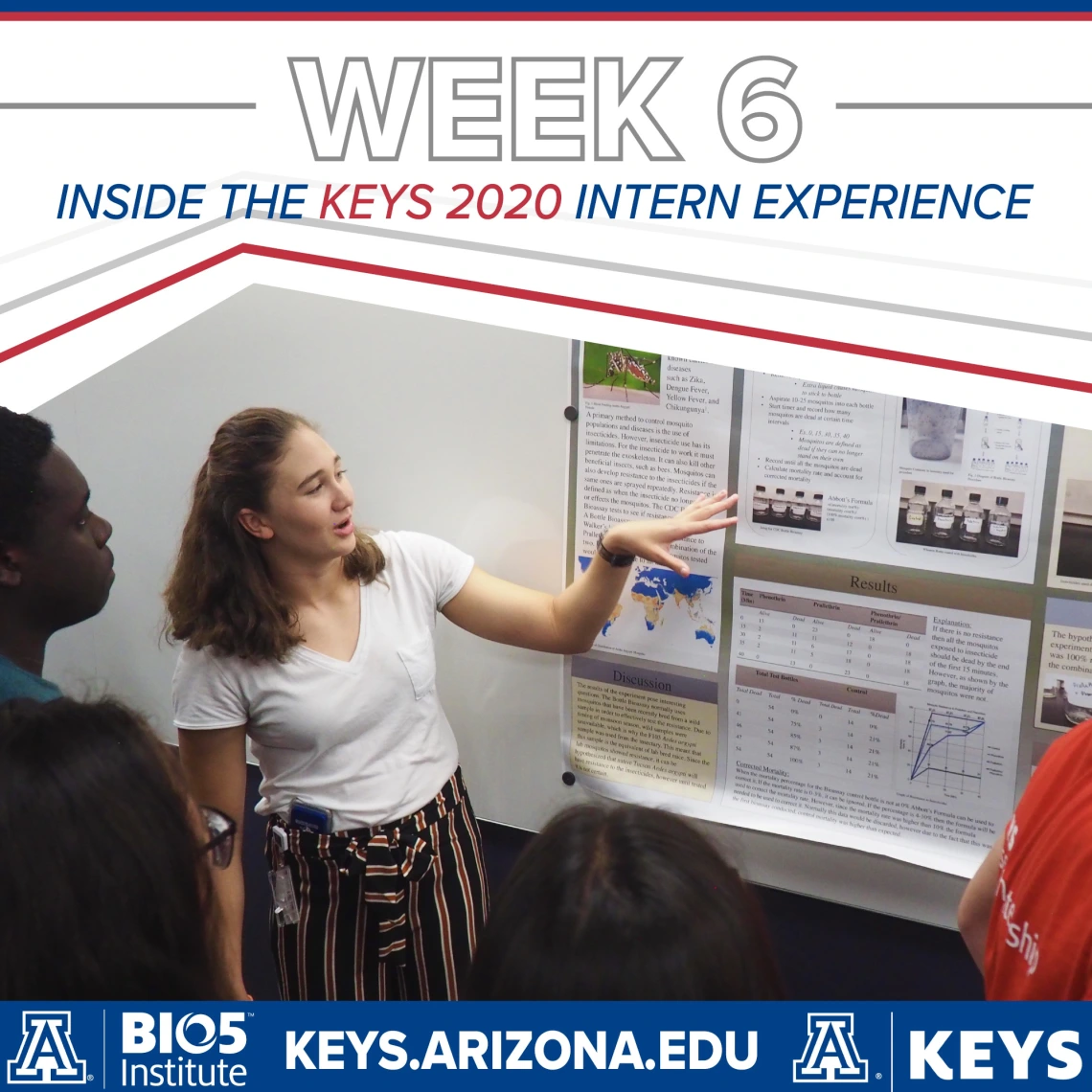KEYS Check-In – Week 6
Follow along with four interns during their sixth week participating in the KEYS virtual research internship program.

Talented high school students participating in the Keep Engaging Youth in Science (KEYS) Research Internship tied the loose ends on their research projects and finalized their presentations during the penultimate week of the seven-week summer program.
“We’ve been working on research projects for five to six weeks,” said Nik Mathur, an intern in the lab of Dr. Pascale Charest. “It’s cool that we are now able to see the bigger picture. We’re able to look at our posters, take a step back and reflect on all we’ve accomplished this summer.”
Presentation prep
Interns wrote their last lines of code and produced their final graphs this week as they shifted their attention away from their research project and put the finishing touches on their posters, slideshows and elevator pitches last week.
“A few weeks ago we were looking at some of the past KEYS posters, and they all looked so professional. I thought to myself, ‘How could I ever create a poster that looks like that?’” remembers Esha Mathur, an intern in the lab of Dr. Bonnie Hurwitz. “Now that I’ve finished my own poster, I’m really proud of myself and the work that I’ve done.”
Though initially worried about their productivity, both Esha and her sister Sonia, an intern in the lab of Dr. Leif Abrell, now ironically have more data than can fit on their posters. Esha said she has so much information on the viruses she identified in moss and bacteria samples that she quickly ran out of space for her introduction and conclusions. Sonia needed to rearrange her poster to find the ideal balance between her graphs of rainwater contaminants and background information. Both girls said their mentors provided invaluable insight on optimizing limited poster space by including only the most critical information.
Having carefully refined the wording on her poster the week prior, Christina Niyigena, an intern in the laboratory of Dr. Michael Marty, enjoyed choosing the colors and design for her poster this week. White is the traditional background color for scientific posters, but Christina let her personality shine by adding splashes of light purple.
Interns practiced their virtual poster presentations with their research labs and KEYS Crew leaders, aiming to impress their friends, family and mentors with their high-impact research discoveries and accomplishments during Presentation Week.
For Nik, juggling the delivery of his presentation behind a computer screen while navigating the videoconferencing platform was a challenge. Nik has grown accustomed to moving around and using a laser pointer while looking at his audience during the countless in-person presentations he’s given at school, so he appreciated the ability to find a new virtual presentation rhythm with the help of his KEYS Crew mentor, Jordan Pilch.
Multiple practice sessions allowed both Esha and Sonia to address technical challenges. In the middle of Esha’s practice presentation, her computer crashed, and Sonia had difficulty advancing her presentation to the next slide. They are both grateful for the patience of their mentors in helping them work out the kinks.
“This is the first time we’ve ever made a poster before, so it was really great to have the support from the lab and KEYS Crew mentors to give us the confidence we need,” Esha said.
Career reflections
Saving one of the best story tellers for last, Dr. Nathan Cherrington, Associate Dean for Research and Graduate Studies in the College of Pharmacy, spoke to the students on July 16 about career planning. Dr. Cherrington approached his seminar in a unique way, as he told stories about academic and professional mishaps – like changing his college major two weeks before graduating – with the goal that the interns would learn from his mistakes.
Though years from settling on their future career paths, Dr. Cherrington encouraged the students to start exploring their options now. He told the students to go beyond mentally contemplating their passions by actively showing an interest. Speaking from experience, Dr. Cherrington encouraged the high schoolers to get involved, whether through continuing their research internships, volunteering in a hospital, or enrolling in classes outside of their future college majors that intrigue them.
Like the prior speakers, Dr. Cherrington’s seminar provided an opportunity for Christina reflect on her goal of becoming a doctor. Though she desires to combine her passions for patient care, neuroscience and biomedical engineering as a medical professional, the KEYS seminars have opened Christina’s eyes to exploring other interests. She’s now looking forward to adding economy, finance and philosophy classes to her schedule as she begins college at UArizona this fall.
“I’m getting a lot out of the KEYS program in terms of my career and being more open to new experiences,” Christina said.
Get the backstory on these four interns and their projects, and hear about their progress during Week 3, Week 4 and Week 5.
About KEYS
The KEYS program is led by the BIO5 Institute and is funded by BIO5 and generous supporters including individuals, families, companies, foundations and various UArizona faculty, colleges and departments. The Technology and Research Initiative Fund (TRIF) that helped launch BIO5 almost 20 years ago continues to be a catalyst in enabling effective, cross-disciplinary bioscience research, innovation and impact at the University of Arizona, and enables world-class student engagement programs like KEYS. For additional information about the KEYS Research Internship Program, email keys@bio5.org(link sends e-mail).
About the University of Arizona BIO5 Institute
The BIO5 Institute at the University of Arizona connects and mobilizes top researchers in agriculture, engineering, biomedicine, pharmacy, basic science, and computational science to find creative solutions to humanity’s most pressing health and environmental challenges. Since 2001, this interdisciplinary approach has been an international model of how to conduct collaborative research, and has resulted in disease prevention strategies, promising new therapies, innovative diagnostics and devices, and improved food crops. For more information, visit BIO5.org.

